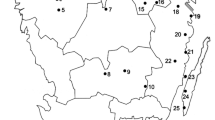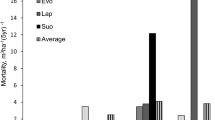Summary
Death of trees (>4.5 cm dbh) and saplings (1.4 m tall–4.5 cm dbh) was monitored over 5 years in a Southern Mixed Hardwood Forest to determine causes of death, death rates, and to assess the nature and direction of forest change. Most trees died standing (77%), presumably the result of pathogen attack or adverse physiological condition; knockdown by other trees (10%) and wind breakage (11%) were other common causes of death. Frequency of wind break and knockdown varied with size, but standing death did not. Most trees (64%) and some saplings (26%) died outright (complete death of the genetic individual); the others had sprouts or living residual parts. For some species, survival of residual parts was high, and so resprouting or persistence may be important in population recruitment. For others, low survival of residual parts means that sprouting does not effectively prolong the life of an individual. Most populations were stable or declining slightly. Shade-intolerant species showed higher death rates in small size classes than did the more tolerant species, so in the absence of disturbance one might expect some change in species composition toward the putative climax dominants.
Similar content being viewed by others
References
Abrell DB, Jackson MT (1977) A decade of change in an old-growth beech-maple forest in Indiana. Am Midl Nat 98:22–32
Baker SF (1949) A revised tolerance table. J For 47:179–181
Botkin DB, Janak JF, Wallis JR (1972) Some ecological consequences of a computer model of forest growth. J Ecol 60:849–872
Brewer R, Merritt PG (1978) Windthrow and tree replacement in a climax beech-maple forest. Oikos 30:149–152
Campbell RW, Sloan RJ (1977) Forest stand responses to defoliation by the gypsy moth. For Sci Monogr 19 (supplement for For Sci 23(2))
Christensen NL (1977) Changes in structure, pattern, and diversity associated with climax forest maturation in Piedmont, North Carolina. Am Midl Nat 97:176–188
Delcourt HR, Delcourt PA (1974) Primeval magnolia-holly-beech climax in Louisiana. Ecology 55:638–644
Deshotels JD (1978) Soil survey for the Big Thicket National Preserve, Texas. US Dep Int-Nat Park Serv, US Dep Agric-Soil Cons Serv, Texas Agric Exp Sta, College Station, Texas
Forcier LK (1975) Reproductive strategies and the co-occurrence of climax tree species. Science 189:808–810
Fowells HA (1965) Silvics of the forest trees of the United States. US Dep Agric Handbook No 271
Goff FG, West D (1975) Canopy-understory interaction effects on forest population structure. For Sci 21:98–108
Harcombe PA, Marks PL (1977) Understory structure of a mesic forest in southeast Texas. Ecology 58:1144–1151
Harcombe PA, Marks PL (1978) Tree diameter distributions and replacement processes in southern forests. For Sci 24:153–166
Hartshorn GS (1972) The ecological life history and population dynamics of Pentaclethra macroloba, a tropical wet forest dominant, and Stryphnodendron excelsum, an occasional associate. PhD Thesis, Univ Washington
Hartshorn GS (1977) A matrix model of tree population dynamics. In: Golley FB, Medina E (eds) Tropical ecological systems: trends in terrestrial and aquatic research, pp 41–51. Springer-Verlag, New York
Hursch CR, Haasis FW (1931) Effects of the 1925 summer drought on southeastern Appalachian hardwoods. Ecology 12:380–386
Johnson FL, Bell DT (1975) Size-class structure of three streamside forests. Am J Bot 62:81–85
Keister TD (1972) Predicting individual tree mortality in simulated southern pine plantations. For Sci 18:213–217
Leak WB (1970) Successional changes in northern hardwoods predicted by birth and death simulation. Ecology 51:794–801
Marks PL, Harcombe PA (1981) Forest vegetation of the Big Thicket, southeast Texas. Ecol Monogr 51:287–305
McLeod CA (1971) The Big Thicket forest of east Texas. Texas J Sci 23:221–233
Monserud RA (1976) Simulation of forest tree mortality. For Sci 22:438–444
Murphy PA (1976) East Texas forests: status and trends. US Dep Agric For Serv Bull SO-61
Nesom GL, Treiber M (1977) Beech-mixed hardwoods communities: a topoedaphic climax on the North Carolina coastal plain. Castanea 42:119–139
Nixon ES, Marietta KL, Littlejohn RO, Weyland HB (1980) Woody vegetation of an American beech (Fagus grandifolia) community in eastern Texas. Castanea 45:171–180
Quarterman E, Keever C (1962) Southern mixed hardwood forest: climax in the southeastern coastal plain, U.S.A. Ecol Monogr 32:167–185
Runkle JR (1981) Gap regeneration in some old-growth forests of the eastern United States. Ecology 62:1041–1051
Schafale MP, Harcombe PA (1982) Presettlement vegetation of Hardin County, Texas. Am Midl Nat (in press)
Schmeltz DV, Lindsey AA (1965) Size-class structure of old-growth forests in Indiana. For Sci 11:258–264
Shugart HH Jr, West DC (1980) Forest succession models. Bio-Science 30:308–313
Sinclair WA (1964) Comparison of recent declines of white ash, oaks and sugar maple in northeastern woods. Cornell Plantations 20:62–67
Staley JM (1965) Decline and mortality of red and scarlet oaks. For Sci 11:2–17
Stephens GR (1981) Defoliation and mortality in Connecticut forests. Conn Agric Exp Stn Bull 796, New Haven, Connecticut
Stephens GR, Waggoner PE (1980) A half century of natural transitions in mixed hardwood forests. Conn Agric Expt Sta Bull 783, New Haven, Connecticut
Watson GE (1975) Big Thicket plant ecology: an introduction. Big Thicket Museum Publ Ser No 5, Saratoga, Texas
Westing AH (1966) Sugar maple decline: an evaluation. Econ Bot 20:196–212
Yarranton M, Yarranton GA (1975) Demography of a jack pine stand. Can J Bot 53:310–314
Author information
Authors and Affiliations
Rights and permissions
About this article
Cite this article
Harcombe, P.A., Marks, P.L. Five years of tree death in a Fagus-Magnolia forest, southeast Texas (USA). Oecologia 57, 49–54 (1983). https://doi.org/10.1007/BF00379561
Received:
Issue Date:
DOI: https://doi.org/10.1007/BF00379561




